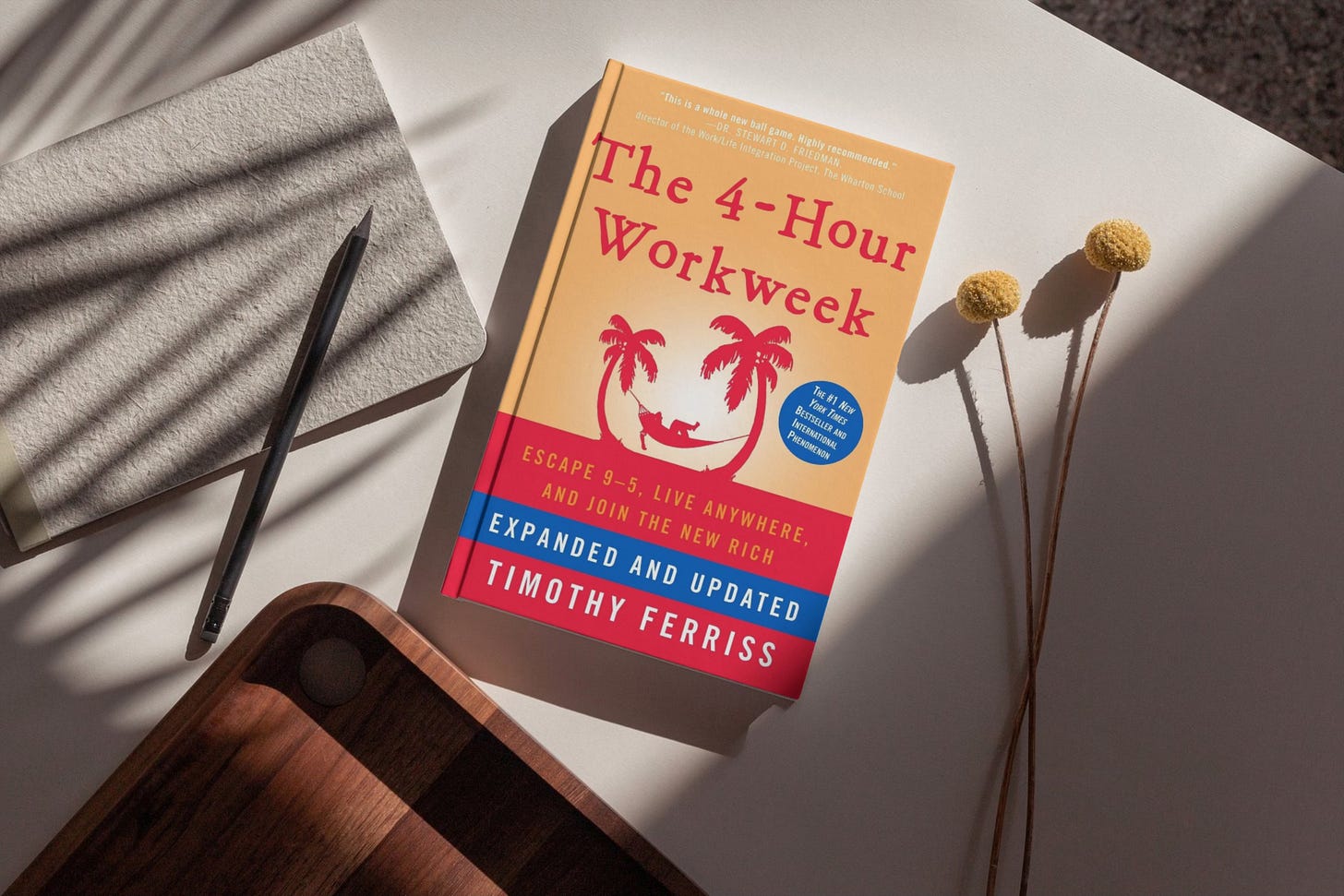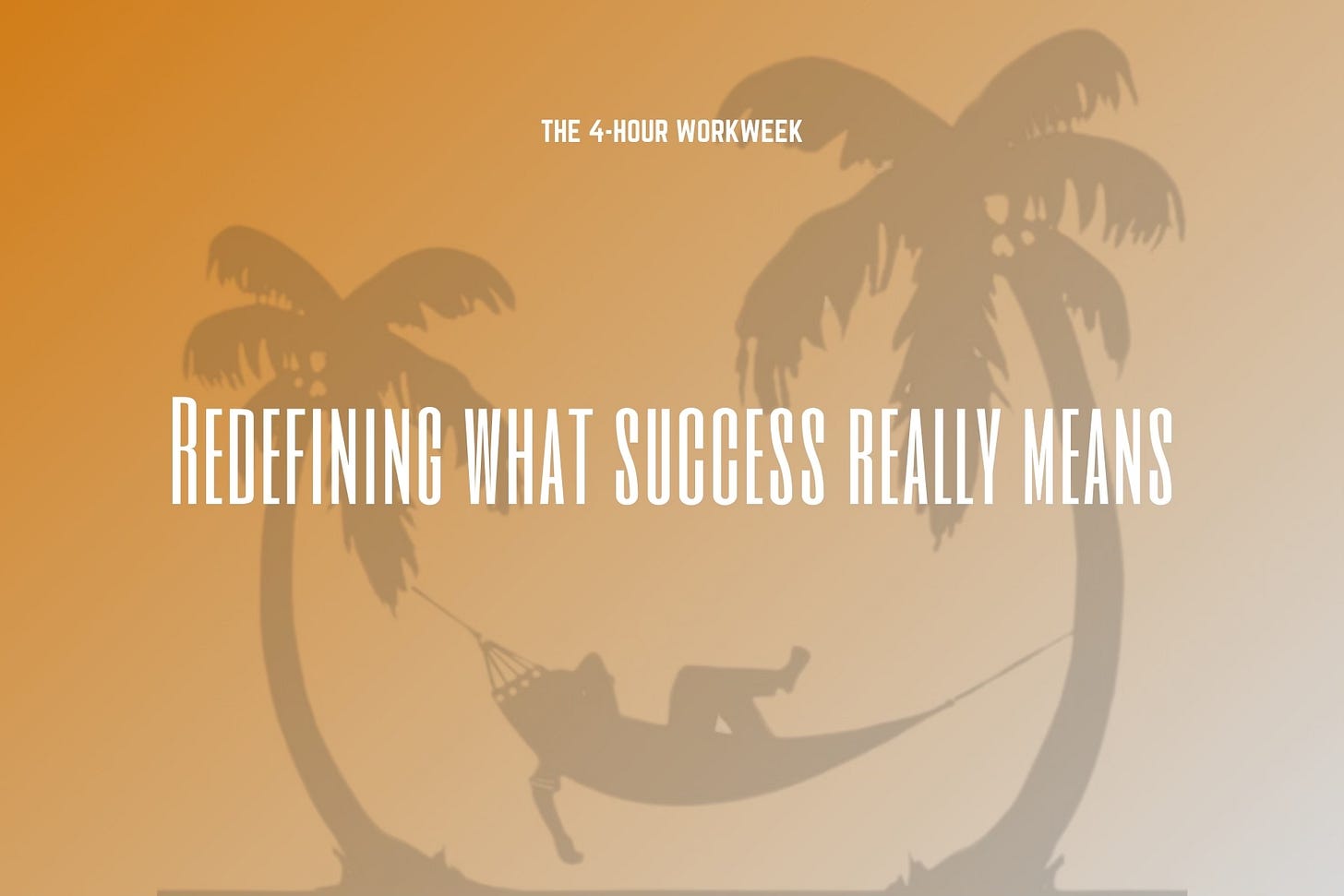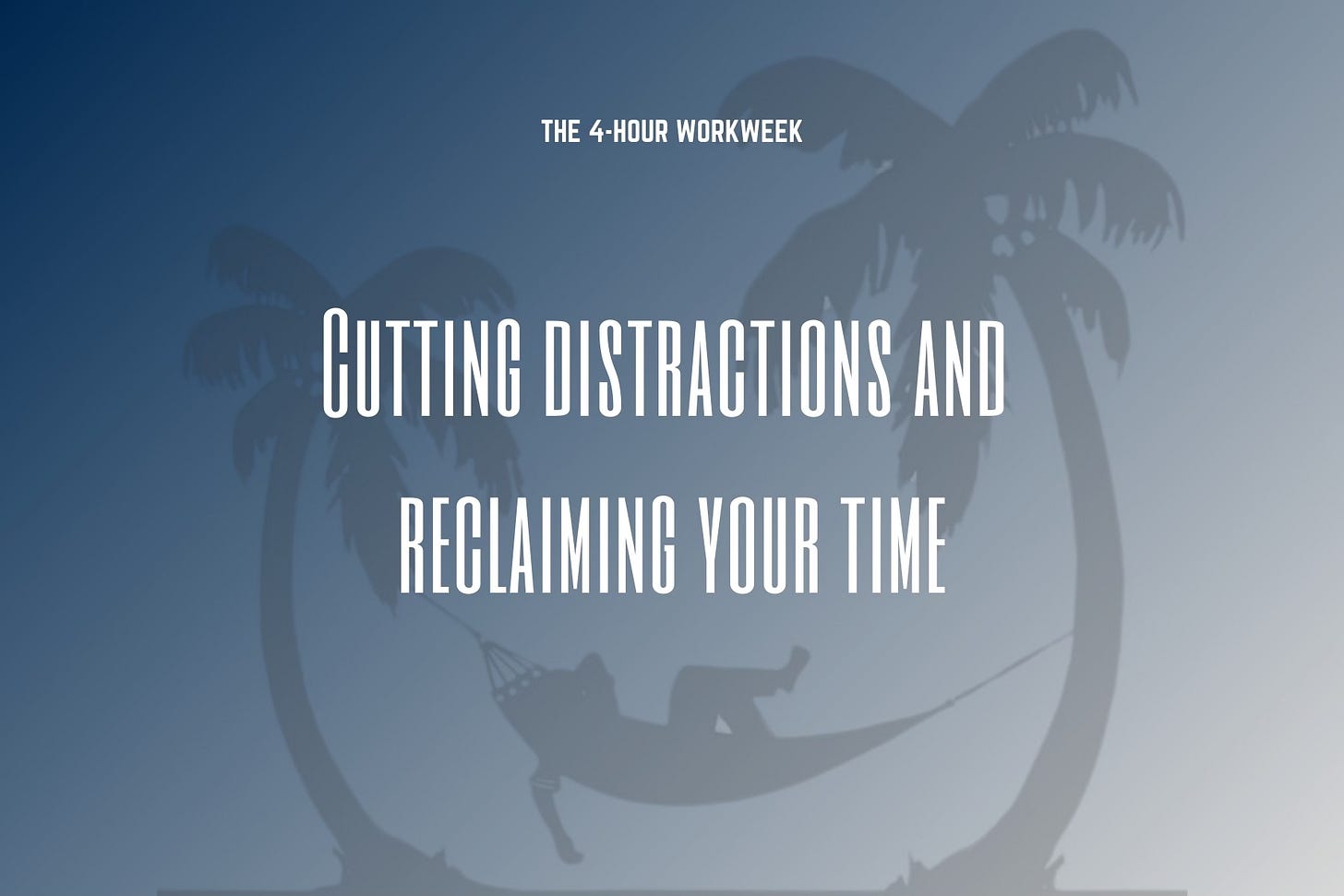A lot of people ask what inspired me to quit my job and start this life. The truth is, it wasn’t one big event—but one small book that shifted everything.
Today, I want to share the book that changed my life by helping me overcome fear, clarify what I truly wanted, and finally quit my job to become a digital nomad: The 4-Hour Workweek by Tim Ferriss.
I read this book in May/June 2020. Shortly after, I announced to my company that I would be leaving the following year, and I left on April 30th 2021.
From the outside, everything looked perfect—I had a great job, good income, lived in Miami… yet I felt stuck. Something was missing.
The idea of making a change had been in my head for a while. I loved the company I worked for, and I loved the people, but I wasn’t having fun anymore. The spark was gone.
But it was tough. See, I had all the freedom in the world there—the founders trusted me to do my job, so they let me do my thing as I wanted. I was the only employee in the US while the rest of the team was in France. My wife and I loved our life in Miami; it changed us, saved us. I was earning good money. Some would say we had it all… and in a way, we did!
The old me would have stayed. All the boxes of a successful life were pretty much checked.
However, after the growth I experienced in Miami following the loss of our baby boy, I wasn’t the same person. A good job making good money wasn’t going to fulfill me anymore. I wanted to thrive, live life to the fullest—and I meant it.
I had started working on side hustles to see if I could make money “myself.”
But I still had some mental roadblocks to overcome. What should I be doing? Am I being stupid thinking about leaving this dream life? What should I do? What do I want?
That’s when I picked up The 4-Hour Workweek on my Kindle.
I’d been listening to Tim Ferriss’ podcast for a while. I heard many people sharing about the impact of the book. It was my turn.
Behind the catchy and provocative title, The 4-Hour Workweek is a book designed to inspire you to create a life with more freedom and flexibility, by rethinking how you work, earn, and live—which was exactly what I was looking for!
Tim Ferriss introduces the concept of “The New Rich”—people who value time, mobility, and autonomy over just money or status. That resonated deeply!
The book is divided into four main, thorough sections. I will not dive into every aspect of them. I’ll only highlight what really resonated with me, and most importantly, how I incorporated the ideas into my life. I want to share this because I think too often people read self-development books, they get the idea, but they never apply them. I want to show you it’s possible.
D - Definition (Redefining what success really means)
In this part, Tim Ferriss encourages you to (re)define what matters to you and how you define success. He challenges the whole retirement concept and introduces the idea of “mini-retirements.”
I LOVED this section. It sort of validated a lot of the work I’d been doing since moving to Miami—reconsidering my life, my priorities, and what I wanted my future to look like.
It convinced me that I was on the right track. ✅
What was important for me was enjoying my life, truly living now rather than waiting to be retired. The traditional path wasn’t the only way to live. The concept of mini-retirements planted the seed that I shouldn’t wait until I’m 65 and a potential retirement to start traveling, experiencing things, and stop postponing happiness, joy, and fun decades away in an uncertain future.
E – Elimination (Cutting distractions and reclaiming your time)
In this part, Tim Ferriss emphasizes the importance of getting rid of distractions and being much more intentional with your time, both in your personal and professional life.
I took some of the concepts in this section to heart. I applied them mainly to my personal life first by really assessing what I was doing and making cuts. The goal was to optimize the 16 hours of the day I was awake and to use them with intention. It wasn’t an overnight change, but since then I’ve made gradual choices:
Less TV 📺, more podcasts 🎧.
Less dumb scrolling 📱, more reading 📖.
Surrounding myself with people who bring value to my life and eliminating toxic relationships that didn’t align with this new version of me.
Those are a few examples. Since then, I deleted most social media apps from my phone and even my Instagram account.
I made changes in my environment to remove distractions: something as little as stopping 95% of notifications on my phone helped reclaim so much of my time. Same with deleting apps. I often pick up my phone with not much to do there, so I put it back down quickly.
He also talks about the 80/20 rule, and how 80% of results come from 20% of effort. I haven’t fully mastered this yet because I’m still in the figuring-things-out phase of entrepreneurship, but I try to apply it the best I can and I use it when I help my clients strategize their businesses.
A – Automation (Making work smarter, not harder)
In this part, Tim Ferriss shares about optimizing your work and businesses so you can eventually automate as much as possible and reach this dream goal of working only 4 hours a week and generating as much passive income as possible.
This section made me dreamy! Imagine being able to make a living while working less than a day a week. What would have sounded completely unrealistic to the “old me” was now something I could envision because I’d seen people doing it.
I haven’t completed this one at all unfortunately, but every time I start something, I’m intentionally designing it so that the business could one day be sustainable without me having to work full-time on it. I try to make choices so scaling doesn’t mean more resources, more time, more more more.
For example, I’ve built my current business—consulting, web design services, and intentional living coaching—in a way that allows me to reach a certain revenue level without having to work with clients 40 hours a week. That gives me the flexibility to manage the rest of my work on my own terms. I’ve designed my offers to suit my lifestyle—not the other way around.
This section talks about delegating a lot of work to a virtual assistant in a low-income country so you can use your time on high-value tasks. That was very controversial at the time, but with the rise of Fiverr and other platforms connecting freelancers, I think this is very relevant these days. I haven’t made the jump, but I do my best to automate or optimize as much of what I do as possible to make my life easier. It’s also something I now help other solopreneurs and creatives with, so they can reclaim their time and focus their energy on their craft.
L – Liberation (Working from anywhere in the world)
In this part, Tim Ferriss dives into the world of location independence. What steps can you take either as an employee or a business owner to break free from the office and give yourself the option to live & work from anywhere in the world? He also emphasizes that such a lifestyle can be accessible to regular people, not just millionaires.
You’re telling me that if I make the right decisions and work for it, I could live a life on my own terms, prioritize what’s important to me, work part-time, and make enough money to live anywhere I want!?! 🤯
SIGN ME UP!!! 🤩
This section was crucial in my choice of becoming a digital nomad. Until then, traveling the world while working was just a dream—not something conceivable or possible to someone like me.
But Tim gives very practical advice on how you can get there, whatever your situation is.
That was a defining moment which shaped my future and how I’ve been living my life since 2021!
Fear Setting
I kept the best for the end, though 😉
The most transformational part of the book to me was the Fear Setting exercise.
If you’re not familiar with it, I invite you to watch Tim’s TED Talk about it:
This is what made me take action. As I said earlier, many of us read books but never apply their teachings and principles.
This exercise is what made me do it and quit my job.
It’s simple yet super powerful:
📝 Step 1 – Define: List everything you fear might happen if you take action.
For me, there was a lot. Things like: What if I can’t make money to live? What if I can’t find a job ever? Am I going to become totally broke and homeless? What are my parents going to think? I had a lot to unpack.
🛠️ Step 2 – Prevent: Identify ways to reduce the likelihood of each worst-case scenario.
Ok, what can I do to limit the risks basically? That was helpful. For example, rather than quitting my job straightaway, I gave pretty much a 1-year notice. This gave me time to save money and work on my side hustles so by the time I quit they would be making some money.
🚑 Step 3 – Repair: Plan how you could repair the damage if the worst happened.
Alright, if shit hits the fan and all my nightmare scenarios I listed before become true, then what? What could I do about it? Well, if I can’t make money myself and I burn all my savings (which I would never do), even though they won’t be happy, I’m sure my parents would let me stay with them and help me. Same for Rosie’s parents. And even if I cannot find another great job, I still have my skills and experience, so I should eventually be able to find something—even if I have to work at McDonald’s for a while. It’s very unlikely that I would be homeless and totally broke, let’s face it.
It might be shit, my ego and pride would hurt, but I could recover from the worst.
Taking the time to go through this exercise—writing it in my notebook (I wish I had it with me, but it’s somewhere at my parents’ house) and REALLY thinking deeply about it for hours—was such a powerful moment.
It changed me.
My fears were gone.
I had in front of my eyes the proof that even in the unlikely scenario where everything crumbled around me, even if every single thing went as badly as it possibly could… I would be fine. A little bruised, but fine.
In the meantime, I would have experienced traveling the world with my wife, trying to build my own business, and doing my best to live a unique life. Could I really regret all that even if everything fell apart? Maybe. But the memories and experiences would never go away.
The final part of the exercise was even better:
Consider the Consequences of Inaction: Easy—Not taking action would have meant accepting a job I wasn’t enjoying. Spending 8 hours a day doing something I didn’t want to do. It would have meant settling for not living my best life and breaking the promise I made to my baby boy. No way.
Consider the Potential Benefits of Taking Action: The upside? Seeing the world, experiencing things that only a small portion of the population gets to experience. Potentially reaching financial independence, where I could work a few hours here and there while enjoying life and traveling the world. Definitely worth “the risk.” 🌎✨
That was the final nail in the coffin! 😆
All the doubts were cleared by then.
All I had to do now was sit down with Rosie so we could deeply think about what we would do between now and the time my job (and consequently our time in Miami) ended… but also what we wanted to do next when “everything” would become possible?
Now that all the fear was lifted, that was easy.
I could not recommend this book enough.
It’s a little old, but the core concepts are more valid than ever. It challenges the status quo and gives you tools to think outside the box so you can design an intentional life you genuinely care about.
If you’ve ever had a big dream but hesitated because of fear, the Fear Setting exercise can change everything—it gave me the push I needed, and it could do the same for you.
You can easily do it on any piece of paper, but I created a workbook for you that you can print, which will guide you through it. 😊
💭 If you’ve read The 4-Hour Workweek, I’d love to hear what stood out to you—or if you haven’t, what’s a book that changed how you see life or work?
📚 Love exploring thought-provoking books? Check out my other reflections to uncover how timeless stories and powerful ideas can inspire growth and perspective.








Amazing! Thank you for sharing this!
Thanks! Sounds exactly like what i need. I look forward to reading it.